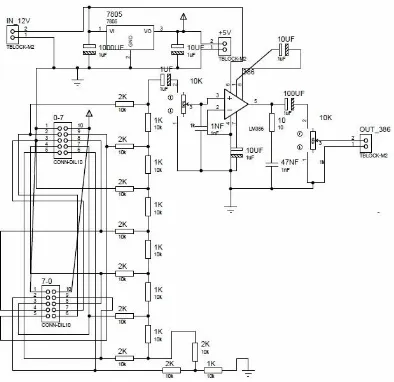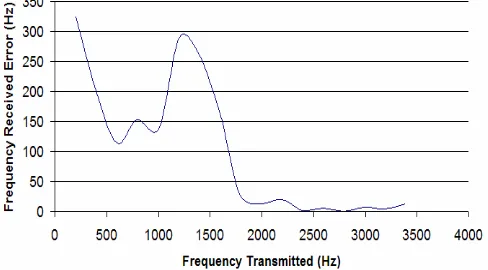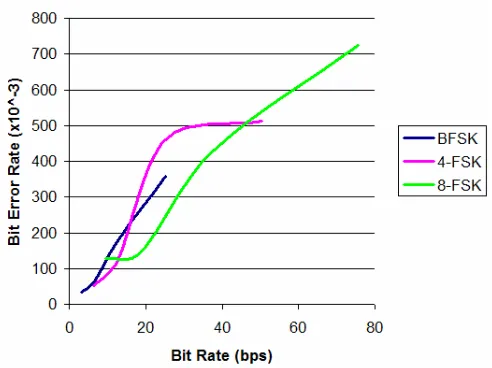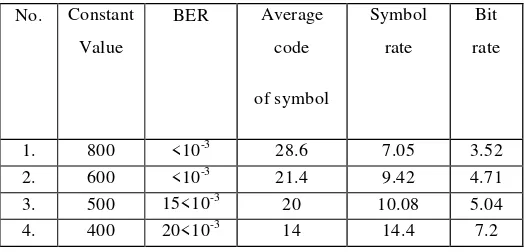DESIGN, IMPLEMENTATION, AND ANALYSIS OF ADAPTIVE
M-ARY FREQUENCY SHIFT KEYING ON GSM VOICE CHANNEL
Oka Mahendra1, Sugihartono2, Heroe Wijanto3
1
Research Center for Informatics, Indonesian Institute of Sciences
1,3
School of Telecommunication Engineering, Telkom University
2
School of Engineering and Informatics, Bandung Institute of Technology
1
[email protected], [email protected], [email protected]
Abstract
A mobile voice channel is a high priority service in cellular communication systems, has a wide coverage, and is almost always available. With these advantages, mobile voice channels can be used to transmit digital data remotely in rural areas that are not covered with 3G/4G networks. Non-adaptive modulation
Keywords: adaptive modulation, MFSK, voice channel, zero crossing demodulator, adaptive multi rate.
1. Introduction
The proposed communication system in this thesis is based on the need for a more reliable communication
system to transmit data from weather stations to the monitoring station. In a previous research conducted by Oka
Mahendra [1–4], we have made an intelligent data logger system. The data logger reads the data from the sensors
which can be configured based on the type of sensor and sensor value [1]. Communication system using Short
Message Service (SMS) was added in the data logger [2]. By using SMS, the data transmitted from the sensor from
a remote station (data logger) to the monitoring station (master). SMS data transmission system used in these
systems is reliable, but it is relatively expensive. For a cheaper solution, we developed a communication system for
data logger with General packet radio service (GPRS) [2]. GPRS systems meet the constraints in the network
coverage and reliability. For data communication system in weather stations, failure rate on the GPRS system is
5.7 % [3] and 5.18 % [4]. To improve the reliability, the chosen alternative solution is to modulate the data on the
mobile voice channel, because the use of the mobile voice channel is considered quite reliable and has wide
coverage in each region.
In this research, the data will be modulated on the mobile voice channel. Testing will be performed primarily
on the Global System for Mobile Communications (GSM) voice channel. We plan to use this channel for the
weather stations of P2I (Research Center for Informatics) LIPI (Indonesian Institute of Sciences). Some of them
will be placed in Cimahi, Bangka, Belitung, and Jakarta.
Communication system through GSM voice channel has been proposed by several previous researchers.
Rashidi [5] proposed and tested a method of digital data transmission over GSM voice channel. Chmayssani[6]
modulation was used. Ali [8] conducted research to find most optimal MFSK configuration on the GSM voice
channel. In a research conducted by Ladoe [9], data are encoded into the symbols, and the symbols are voice coded
as they were speech, modulated into the GSM signal, sent over the air, GSM demodulated, voice decoded, and
converted back to data.
The major challenges in the data communication over a mobile voice channel are the operation of speech
coder or vocoder (AMR) and Voice Activity Detector (VAD) which makes the voice signal quality decreases.
These challenges already have been addressed by previous researchers [5]-[9] with non-adaptive modulation
configuration.
The other problem in sending data over mobile voice channel is how to get optimal effective data rate
according the AMR rate. The optimal modulation configuration must be adaptively adjusted according the rate of
AMR. If it is not adaptively adjusted, the modulation configuration will be chosen from the one that works at the
lowest rate of AMR, whereas the other modulation configuration may obtain higher data rate at higher AMR rate.
With the fixed modulation configuration, the effective data rate is not optimum.
The adaptive MFSK modulation proposed in this research has higher data rate than fixed lower rate
There are hundreds of millions of new phones every year constructed. So it is necessary that a standard should
be working on them, whenever a new phone is built, and it should be compatible with old technology. Adaptive
Multi Rate (AMR) [15] is operated at various bit rates and can be built into every GSM and WCDMA phone. This
scheme works on virtually any wireless phone.
The GSM AMR Adaptive Multi-Rate (AMR) vocoder is an Algebric Code-exited linear prediction (ACELP)
vocoders. And for adaptive multirate, the bit rates of the codec are 4.75, 5.15, 5.90, 6.70, 7.40, 7.95, 10.2, or 12.2
channel quality rate variations automatically. Modulation and demodulation functions will be designed and
Figure 1 Research design
3.1.1 Feedback Approach
Figure 2 shows the adaptive scheme proposed in this research. The transmitter receives feedback from the
receiver in the form of BER estimation for each modulation configuration. In this research, the BER estimations
will be carried out continuously by the pilot message method.
Figure 2 Proposed adaptive modulation with feedback channel
3.1.2 Signal Strength Indicator Approach
Using feedback channel requires a complex systems design. The system also requires two channels for
transmitting information in one direction only. Another alternative proposed in this project is to use an adaptive
modulation method without feedback as shown in Figure 3. The transmitter uses signal strength indicator from the
modem to get an estimation of channel condition. The signal strength and quality of signals received by Base
Stations (BS) and Mobile Stations (MS) can be influenced by effects resulting from the movement of the mobile,
the overlay of numerous delayed signals caused by reflections, and the other interferences [12]. This phenomenon
is called fading and is classified in profiles such as Constant Phase, Pure Doppler, Rice, Rayleigh and Moving
Propagation fading.
microcontroller. The audio signal is generated by a sinusoidal wave created by the digital to analog converter
(DAC). The DAC is composed of a series of R-2R ladders. The DAC input is given by the microcontroller to
generate a sine wave with a desired frequency. The microcontroller uses a look-up table to generate the sampling
values of the sinusoidal signal. The sinusoidal signal is amplified by an audio amplifier, which on the prototype
uses the LM386 op amp. In the prototype, we used an ATMega8535 microcontroller.
Figure 4 Schematic of the modulator
3.3 Demodulator Implementation
Demodulator uses the principle of the zero-crossing detector. A zero-crossing detector is made using a
comparator. In the prototype, we use the LM393 circuit as shown in Figure 5. The subsequent output of the
comparator is read by the microcontroller to obtain the signal period. In the prototypes, we used an ATMega8535
microcontroller.
4. Data and Analysis
4.1 Single tone GSM Voice Experiments
The single tone audio was transmitted using GSM voice channel. The modem that used in the experiments is
Fastrack Xtend with Indosat IM3 mobile operator. The frequencies that sent was chosen by the most effective
modulator code shown in appendix 1, they are 200 Hz, 395 Hz, 600 Hz, 795 Hz, 1000 Hz, 1196 Hz, 1391 Hz,
1596 Hz, 1792 Hz, 1997 Hz, 2192 Hz, 2387 Hz, 2592 Hz, 2788 Hz, 2993 Hz, 3188 Hz, and 3384 Hz. We make
1000 times of demodulator reading for each frequency. The test result is shown in Figure 6.
Figure 6 Demodulation error at different frequencies through GSM voice channel after averaging 1000 data and
filtering <3500 Hz only
4.2 The proposed modulation system performance
Experiments using the adaptive modulation system proposed in this research was conducted. The first
experiment M from 2, 4, and 8. The second experiment uses fixed 4-FSK with varying symbol time.
4.2.1 Adaptive M-ary modulation with fixed symbol time
The frequencies selected for M-ary FSK carrier is based on the previous experiment using single tone that
gives low error rate. The carier frequencies are: (1) BFSK used frequencies: 1997 Hz and 3188 Hz, (2) 4-FSK used
frequencies: 1997 Hz, 2387 Hz, 2788 Hz, and 3188 Hz, and (3) 8-FSK used frequencies: 1997 Hz, 2192 Hz, 2387
Hz, 2592 Hz, 2788 Hz, 2993 Hz, 3188 Hz, and 3384 Hz.
Figure 7 shows for all m-ary FSK scheme BER increases when bitrate was increased. For the same symbol
rate, the lower modulation scheme gives lower BER with lower bit rate. Based on this experiment, symbol time 6.3
baud was selected for the adaptive modulation scheme. The adaptive modulation scheme was based on Relative
if (frequency>1797 && frequency<=2192) symbol = 3; //1997 Hz if (frequency>2192 && frequency<=2587) symbol = 5; //2387 Hz if (frequency>2587 && frequency<=2953) symbol = 1; //2788 Hz if (frequency>2953 && frequency<=3400) symbol = 4; //2788 Hz
exponential trendlines for the data from table 1. The exponential equation is:
Experiment for finding the suitable constant value (C) were conducted. The aim of this experiments is to find the
suitable constant value (C) that gives error < 10-2. The experiment result is shown in the table 2. The smaller
constant value inflicts the higher BER and the higher data rate.
Table 2 BER performance with various constant value for 1000 bit sent with average RSSI value = 28
modulation C = 400. So the proposed adaptive modulation model:
T 400 (2) RSSIvalue
with T is the code of symbol time.
With adaptive constant value C=400, the proposed adaptive modulation system achieved BER < 2 x10-2
at data rate 7.2 bps.
adaptive modulation scheme without feedback channel, but with RSSI value provided by modem can increase the
higher data rate with acceptable BER compared with lower fixed data rate. The adaptive scheme without feedback
also has lower BER compared with higher fixed data rate.
5.2 Suggestion
For better detection methods in the demodulator, the other demodulator technique can be used, for example,
frequency filter and Fast Fourier Transform (FFT). With better demodulation techniques, the performance of the
[2] D. Syamsi & O. Mahendra, Pemanfaatan Layalan SMS untuk Pengiriman Data Pengukuran Secara
Paket, Prosiding Seminar Nasional Riset Teknologi Informasi, Volume IV, halaman 187, 2009
[3] O. Mahendra & D. Syamsi, Sistem Komunikasi General Packet Radio Switch (GPRS) antara
Datalogger dengan Web Server berbasis PHP dan MySQL, Prosiding Seminar Nasional Open Source,
P2I LIPI, halaman A-26, 2009
[4] A. I. Basuki & O. Mahendra, Aplikasi Pemantau Stasiun Cuaca dengan Javascript dan Google Maps
API, Prosiding Seminar Ilmu Pengetahuan Teknik, Kedeputian IPT LIPI, 2012
[5] M. Rashidi & A. Sayadiyan, A New Approach for Digital Data Transmission over GSM Voice
Channel, 2nd WSEAS Int. Conf. on CIRCUITS, SYSTEMS, SIGNAL and
TELECOMMUNICATIONS (CISST'08) Acapulco, Mexico, January 25-27, 2008
[6] T. Chmayssani, Data transmission over voice dedicated channels using digital modulations,
Radioelektronika, 2008 18th International Conference, 24-25 April 2008
[7] A. Dhananjay, et all. Hermes: Data Transmission over Unknown Voice Channels, MobiCom’10,
September 20–24, Chicago, Illinois, USA, 2010
[8] B. T. Ali , G. Baudoin, O. Venard. Data transmission over mobile voice channel based on M-FSK
modulation, IEEE Wireless Communications and Networking Conference (WCNC), 2013.
[9] C. K. LaDue, V. V. Sapozhnykov, and K. S. Fienberg, A Data Modem for GSM Voice Channel, IEEE
TRANSACTIONS ON VEHICULAR TECHNOLOGY, VOL. 57, NO. 4, JULY 2008
[10] J.C. Whitaker, The Electronics Handbook, Taylor & Francis Group, 2005.
Measurements and Simulations, Blekinge Institute of Technology Karlskrona, Sweden, 2006
[15] Eroupan Standard ETSI, Digital cellular telecommunications system (Phase 2+);Adaptive Multi-Rate
(AMR); Speech processing functions; General description (GSM 06.71 version 7.0.2 Release 1998),




